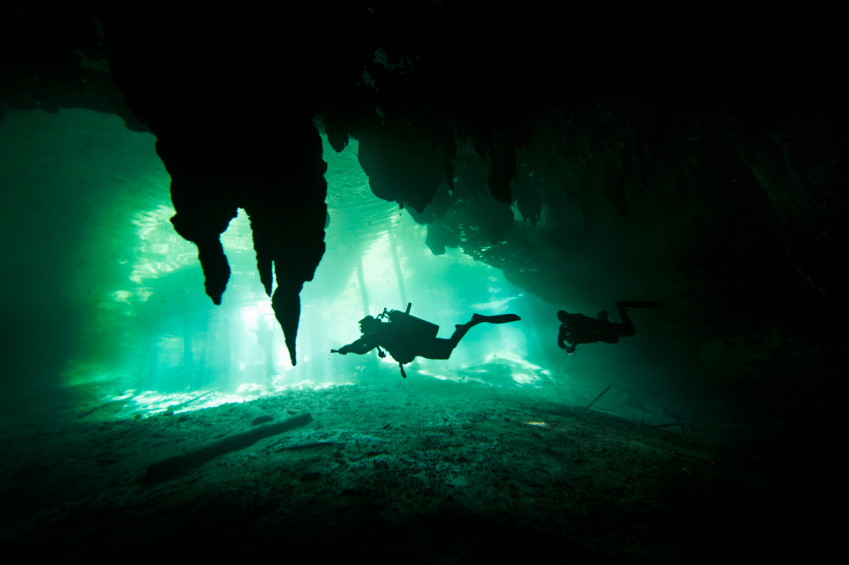
|
The divers’ job duties included vacuuming the floor of the reservoir 15 to 20 feet below the surface. Hinkle Reservoir is a covered reservoir that uses a patented floating tarp design rather than a hard cover. The tarp, which has a surface area of 14 acres when the tank is at full capacity, is bolted to the ground and has hatches in it to enable workers to enter and exit the water, and to insert a 300-foot-long compressed air hose and electrical cords that power the vacuum equipment.
Following a complaint, Cal/OSHA sent an inspector to the site. The inspector discovered that the employer had no confined space entry permit program; workers had not completed a confined space entry permit; divers had not been trained to perform rescue duties; and there was no standby person. The employer was cited for multiple violations of the confined space entry standards and a violation of the diving operations standards.
The employer appealed the citation, stating that the confined space entry standard did not apply to diving operations.
You Can’t Have One Without the Other
The employer’s operations manager appeared to believe that compliance with California’s diving operations rules covered all potential diving hazards and relieved the employer of the necessity of also complying with confined space regulations. He asserted that “every time [our divers] put on a helmet, [they’re] in a confined space,” referring to their diving gear as a confined space.
Your one-stop safety management resource, available 24/7. Go here to take a no-cost site tour or here to try it in your own office!
However, as the Cal/OSHA inspector pointed out, the confined space standard applies to the space itself (in this case, the reservoir) and not to the individuals performing work or to their equipment. And by the criteria of the confined space standard, the reservoir should have been classified as a permit-required confined space.
The reservoir was a confined space because it:
- Was large enough and configured in such a way, that people could bodily enter the space and perform assigned work. The reservoir had a surface area up to 14 acres (it was about 12.5 acres at the time of the inspection), and was up to 20 feet deep.
- Had limited or restricted means for entry or exit. Workers entered the reservoir through a limited number of hatches; the hatch covers had to be opened from the outside.
- Was not designed for continuous employee occupancy.
Great news! BLR’s renowned Safety.BLR.com® website now has even more time-saving features. Take our no-cost site tour! Or better yet, try it at no cost or obligation for a full 2 weeks.
To be a permit-required confined space, the space must have one or more hazardous characteristics. The reservoir was a permit-required confined space because:
- It contained a hazardous atmosphere. In this case, there was no breathable atmosphere in the space.
- It contained a material that had the potential for engulfing an entrant. Liquids are considered to have engulfment potential.
Spaces may also be permit-required if they have an internal configuration in which the entrant could be trapped or asphyxiated by inwardly converging walls or by a floor that slopes downward and tapers to a smaller cross-section, or if the space contains any other recognized safety or health hazard.
The diving operations standards do not directly address confined space hazards; not all underwater operations qualify as confined space entry based on the criteria above.
A Warning for Employers
The employer in this case didn’t recognize a potential hazard because it saw only one set of hazards—the hazards of the dive itself and of the water—while not recognizing the hazards created by the limited means of egress. It’s a common mistake, and one that leads employers to neglect potentially deadly hazards. Make sure, when you’re identifying hazards, that you look at all of the potential dangers of the work and the work environment.
Tomorrow, we’ll look at other workplace water hazards that could lead to drownings.

This is a great catch. I have divers onboard our offshore platform performing marine growth removal annually. During our project meeting, I discuss all safety related issues and ask about what happens when a diver is injured but I never thought of the water being a confined space. Our combined repose is, they Attendant sounds the Alarm and pulls him up by his tether, and we get him into hyperbaric chamber. Great but what if he is tangled or something. I haven’t noticed anyone suited and ready to go in. I will note and bring this up during our next project meeting.
All commercial diving operations (diving for profit) in the US must conducted in accordance to Association of Diving Contractors International standards. In addition these standards are incorporated in USCG regulations for commercial diving, 1910 CFR section regarding commercial diving, ASME PVHO standard, etc. FYI – OSHA has no jurisdiction in Outer Continental Shelf (OCS)(3 miles from the coast line). USCG does. When diving operations performed correctly with minimum required team of 5 people confined space is NEVER issue since there MUST be DRESSED READY TO DIVE STAND BY DIVER with sole purpose of rescuing diver in the water.
So, IMO – in Cal case described in the article diving operations were not perfumed correctly and citation shall be issued for that as well. Regarding Jeff’s comment – if there is no stand by diver dressed and ready to go on you platform send contractor home since they are violating one of the most basic regulations regarding commercial diving. There are many legit commercial diving companies out there to replace them.
I’m HSEQ executive for commercial diving company and ex commercial diver. If you need any further information regarding commercial diving, please, let me know.
Sound procedures to be adopted.